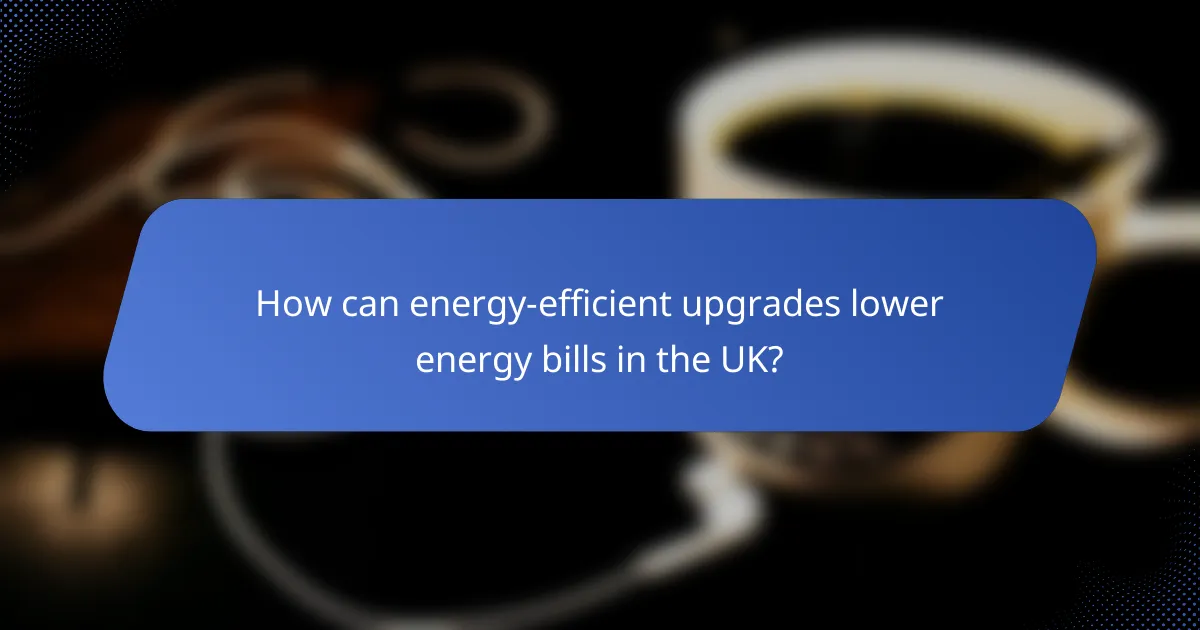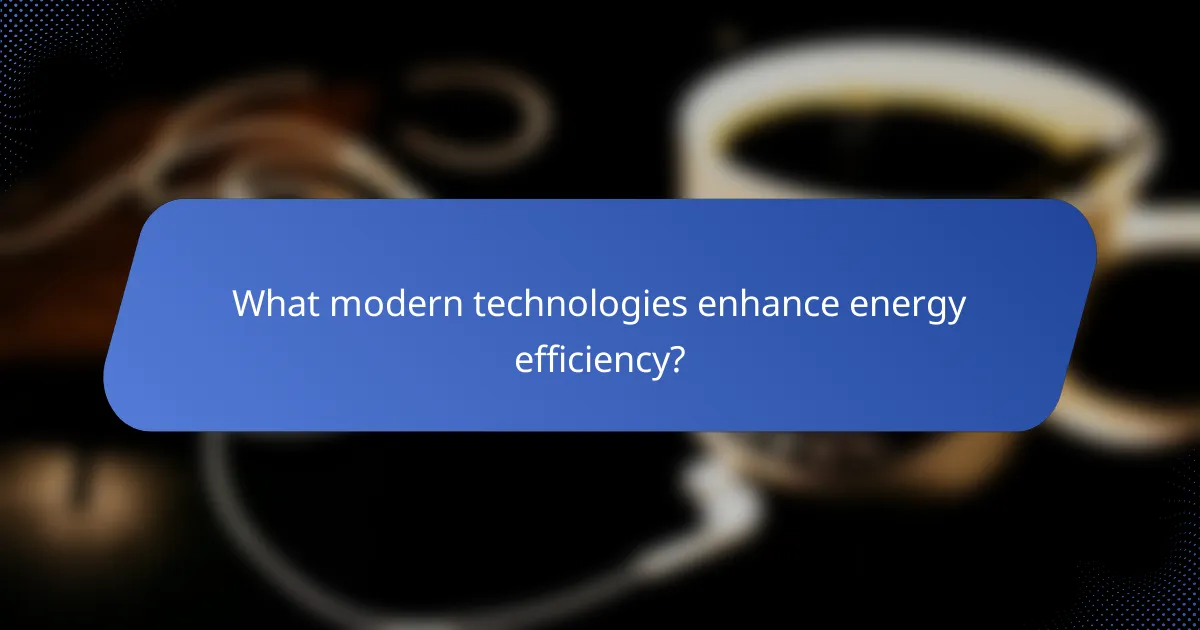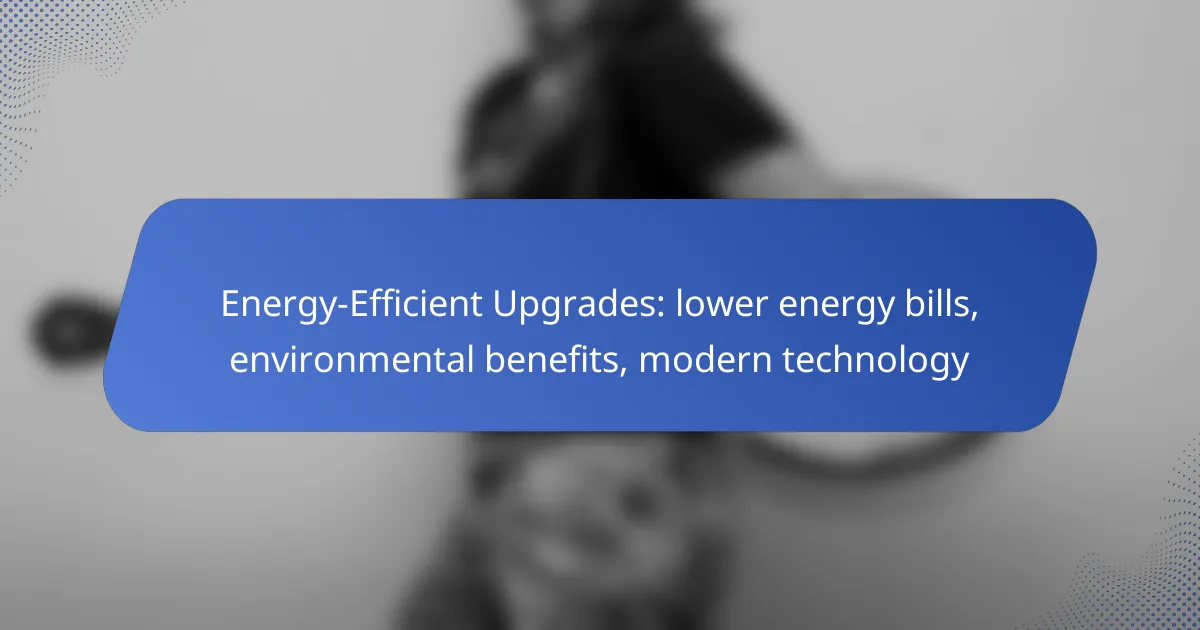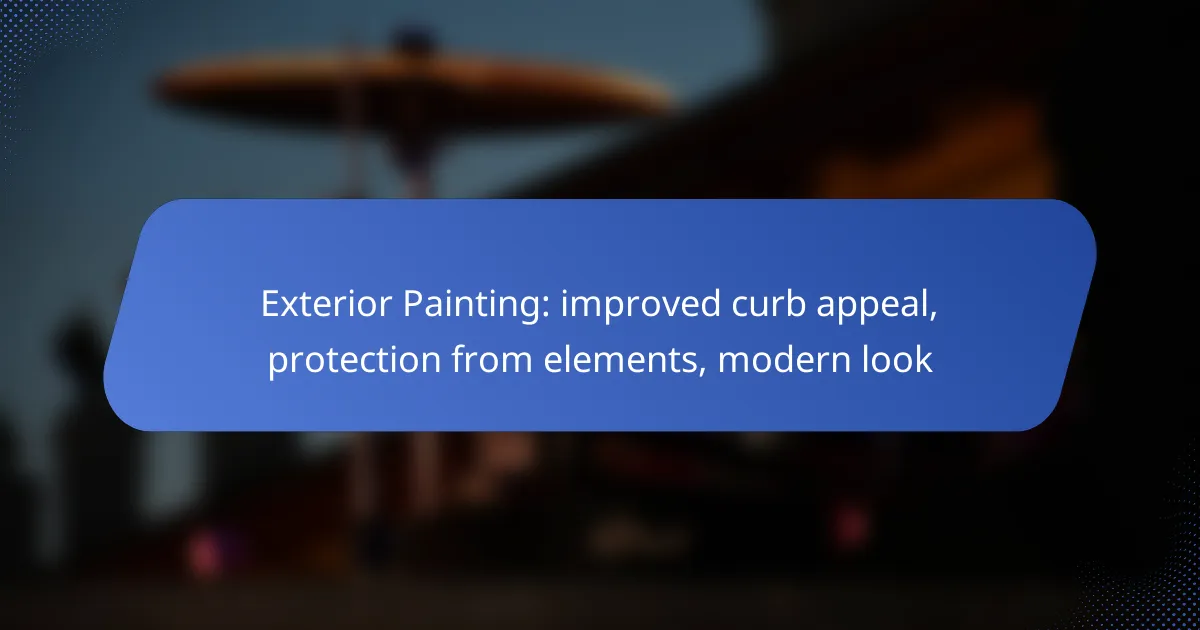Energy-efficient upgrades offer a dual benefit of lowering energy bills and promoting environmental sustainability. By incorporating modern technologies such as smart meters and high-efficiency HVAC systems, households can significantly reduce their energy consumption. These improvements not only save money but also contribute to a healthier planet by minimizing waste and emissions.

How can energy-efficient upgrades lower energy bills in the UK?
Energy-efficient upgrades can significantly reduce energy bills in the UK by minimizing energy consumption and optimizing usage. By implementing modern technologies and practices, households can save money while also contributing to environmental sustainability.
Smart thermostats
Smart thermostats help manage heating and cooling systems more efficiently by learning user preferences and adjusting settings automatically. They can reduce energy usage by up to 20% by ensuring that heating only occurs when necessary.
Consider models that offer remote control via smartphone apps, allowing you to adjust settings even when you’re not home. This flexibility can lead to additional savings, especially during periods of absence.
Energy-efficient appliances
Upgrading to energy-efficient appliances can lead to substantial savings on utility bills. Look for appliances with an A+++ rating, which consume significantly less energy compared to older models.
When replacing appliances, consider the long-term savings versus the initial investment. For example, an energy-efficient washing machine may cost more upfront but can save you tens of pounds annually on energy bills.
LED lighting
Switching to LED lighting can drastically reduce electricity consumption, as LEDs use up to 80% less energy than traditional incandescent bulbs. They also have a longer lifespan, which means fewer replacements and lower overall costs.
To maximize savings, replace all high-use bulbs with LEDs. This simple upgrade can lead to noticeable reductions in your monthly energy expenses.
Insulation improvements
Improving insulation in your home can prevent heat loss, keeping your living space warmer in winter and cooler in summer. Proper insulation can reduce heating and cooling costs by up to 30%.
Focus on areas like lofts, walls, and floors. Consider professional assessments to identify the best insulation materials and techniques for your home’s specific needs.
Solar panel installation
Installing solar panels can significantly lower energy bills by generating your own electricity. In the UK, the Feed-in Tariff scheme allows homeowners to earn money for the energy they produce, further offsetting costs.
Evaluate your roof’s suitability for solar panels, considering factors like orientation and shading. While the initial investment can be substantial, many homeowners find that the long-term savings and potential government incentives make it worthwhile.

What are the environmental benefits of energy-efficient upgrades?
Energy-efficient upgrades significantly reduce environmental impact by lowering energy consumption and minimizing waste. These improvements contribute to a healthier planet through various mechanisms, including reduced emissions and better resource management.
Reduced carbon footprint
Implementing energy-efficient upgrades leads to a lower carbon footprint by decreasing greenhouse gas emissions associated with energy production. For instance, switching to LED lighting or high-efficiency appliances can cut energy use by a substantial percentage, translating to fewer emissions from power plants.
Homeowners can further reduce their carbon footprint by utilizing smart thermostats that optimize heating and cooling. This technology adjusts energy use based on occupancy, ensuring that energy is not wasted when spaces are unoccupied.
Conservation of natural resources
Energy-efficient upgrades help conserve natural resources by reducing the demand for energy production. For example, using energy-efficient appliances decreases the need for fossil fuels, which are finite resources. This conservation is crucial for sustainability and protecting ecosystems.
Additionally, water-saving fixtures, such as low-flow showerheads and faucets, contribute to resource conservation. These upgrades not only lower water bills but also reduce the energy required for heating water, further minimizing overall resource consumption.
Improved air quality
Energy-efficient upgrades can lead to improved indoor air quality by reducing pollutants and allergens. For example, better insulation and ventilation systems help maintain a comfortable environment while filtering out harmful particles, resulting in cleaner air for occupants.
Moreover, by decreasing reliance on fossil fuels, energy-efficient upgrades contribute to better outdoor air quality. This reduction in emissions leads to fewer smog and particulate matter, benefiting both human health and the environment.
Support for renewable energy
Energy-efficient upgrades complement the use of renewable energy sources by maximizing their effectiveness. Homes that consume less energy can more easily transition to solar or wind power, as the reduced demand allows for smaller, more affordable systems.
Incorporating energy-efficient technologies, such as solar panels or energy storage systems, can enhance energy independence. This shift not only supports the growth of renewable energy markets but also contributes to a more sustainable energy future.

What modern technologies enhance energy efficiency?
Modern technologies that enhance energy efficiency include home automation systems, energy management software, high-efficiency HVAC systems, and smart meters. These innovations help reduce energy consumption, lower utility bills, and contribute to environmental sustainability.
Home automation systems
Home automation systems allow homeowners to control various devices remotely, optimizing energy use. For example, smart thermostats can adjust heating and cooling based on occupancy, significantly reducing energy waste.
When implementing a home automation system, consider compatibility with existing devices and the potential for future upgrades. Look for systems that can integrate with energy-efficient appliances to maximize savings.
Energy management software
Energy management software provides insights into energy consumption patterns, helping users identify areas for improvement. This software can track usage in real-time, allowing for informed decisions about energy-saving measures.
For effective use, choose software that offers customizable reports and alerts for unusual consumption spikes. This can help in promptly addressing inefficiencies and avoiding higher energy costs.
High-efficiency HVAC systems
High-efficiency HVAC systems are designed to use less energy while maintaining comfort levels. These systems often meet or exceed ENERGY STAR standards, which can lead to significant savings on heating and cooling bills.
When selecting an HVAC system, consider the SEER (Seasonal Energy Efficiency Ratio) rating; higher ratings indicate better efficiency. Regular maintenance is crucial to ensure optimal performance and longevity of these systems.
Smart meters
Smart meters provide real-time data on energy usage, enabling consumers to monitor their consumption closely. This technology allows users to adjust their habits based on usage patterns, potentially leading to lower energy bills.
Check with your local utility company to see if smart meters are available in your area. Understanding peak usage times can help you shift energy-intensive tasks to off-peak hours, maximizing savings.

What factors should be considered before upgrading?
Before upgrading to energy-efficient systems, consider the initial investment costs, long-term savings potential, and available local incentives. Each of these factors plays a crucial role in determining the overall feasibility and benefits of the upgrade.
Initial investment costs
The initial investment costs for energy-efficient upgrades can vary widely based on the type of technology and installation requirements. For example, upgrading to energy-efficient windows may cost several thousand dollars, while installing a high-efficiency HVAC system could range from a few thousand to over ten thousand dollars depending on the size and complexity.
When evaluating costs, consider not just the purchase price but also installation fees, potential modifications to existing structures, and any necessary permits. It’s essential to get multiple quotes from contractors to ensure you are making a well-informed decision.
Long-term savings potential
Long-term savings potential is a critical factor when considering energy-efficient upgrades. Many upgrades can lead to significant reductions in energy bills, often in the range of 20-50% depending on the technology and local energy rates. For instance, switching to LED lighting or high-efficiency appliances can yield noticeable savings over time.
To maximize savings, calculate the payback period by dividing the initial investment by the annual savings. This will help you understand how long it will take to recoup your costs and start benefiting from lower energy bills.
Local incentives and rebates
Local incentives and rebates can significantly reduce the financial burden of energy-efficient upgrades. Many governments and utility companies offer programs that provide cash rebates, tax credits, or low-interest financing for qualifying upgrades. These incentives can range from a few hundred to several thousand dollars, depending on the project and location.
Research available programs in your area by visiting government websites or contacting local utility providers. Be sure to check eligibility requirements and deadlines to ensure you can take full advantage of these financial benefits.










